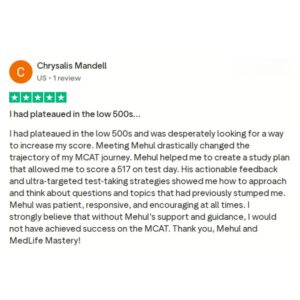Get paired with a 90+ percentile Bio/Biochem scorer to help you master the strategies of this section →
Hi my name is Merrina! I scored a 518 on the MCAT. I'm a mentor here at MedLife Mastery. In this video article, I will be showing you the strategies I use to guide myself through complex Bio/BioChem pathways in difficult passages.
Have you ever read an MCAT passage that looks like this:

After reading that whole sentence, you might have no idea what is going on, and then you feel like you're either panicking or want to give up...
I understand your struggle. I felt the same way during my MCAT journey and I did not know what to do with these complex pathways until I figured out some strategies for it.
Let me take you through them!
Using Abbreviations and Symbols In My Notes
After a couple of practice passages, I realized that my short-term memory does not retain too much information as I am reading the passage. To make it easier for myself, I started taking some notes while reading the passage and using a lot of abbreviations and symbols to save time. Some people call this creating a shorthand for your notes!
For example, I use an upward pointing arrow to mean something is increasing, a downward pointing arrow to mean something is decreasing, and then a horizontal arrow to mean that one compound leads to a reaction of something else. A blunted horizontal arrow means that one compound is suppressing something else.

Sample Question: How I Use Arrows To Help Me
Here is an example of how I use arrows to help me through a passage. The sentence reads:
"Compound A stimulates the production of Compound B."
I write "Compound A" and then a horizontal arrow and then "Compound B."

"Compound B suppresses the release of Compound C."
I use a blunted arrow to connect "Compound B" and "release of Compound C."

Finally, "the release of Compound C will stimulate the degradation of Compound D."
I use a horizontal arrow to connect "release of Compound C" and "degradation of Compound D."

Now I have a little diagram to help me organize what leads to what. Now I’m ready to answer the questions!

The first question reads:
"If I increase the amount of Compound A, how is it going to affect the degradation of Compound B?"
Then underneath my diagram, I'm going to write an upward pointing arrow under Compound A to say that Compound A is increasing.
I would write an upward pointing arrow underneath Compound B, because Compound A leads to Compound B.

If there is more A, then there should be more B.
If there is more Compound B, then that means there's going to be a decreased amount of Compound C because there is a blunted arrow connecting those two.
That means they have an inverse relationship.

Now onto our last task, if we have less release of Compound C, that means there's going to be less degradation of D.
Now I drew another downward pointing arrow underneath "degradation of Compound D."

Altogether, we have the final diagram in our notes to simplify the biochemical pathway:

Notice how in flanking a horizontal arrow, the up and down arrows are pointing in the same direction because they are either both increasing or both decreasing. But flanking a blunted arrow, the up and down arrows have to be opposite. If one thing goes up, the other has to go down and vice versa.
Take note of how much easier drawing arrows has made this question! If you're just thinking about it in your head, it's very easy to mess up which one is increasing and decreasing and get the question wrong.
Now, when you're reading a complicated Bio/BioChem passage, I want you to try out this tip and see how much difference that's going to make.
This tip is not just for taking the MCAT. You can also use it when you're taking notes in class or you're taking another exam and you'll notice how much difference that's going to make because now your notes are very efficient and organized!
Conquering the complex passages and pathways in the Bio/BioChem section doesn’t have to be so dreadful. As you embark on this path, remember that success is not solely defined by content review and speed but by strategic and thoughtful approaches!


 To help you achieve your goal MCAT score, we take turns hosting these
To help you achieve your goal MCAT score, we take turns hosting these 















